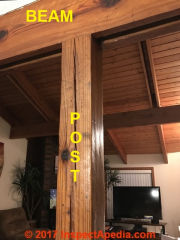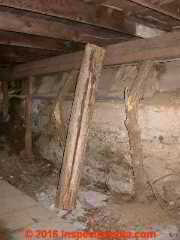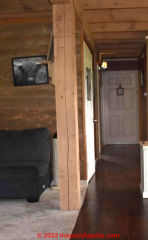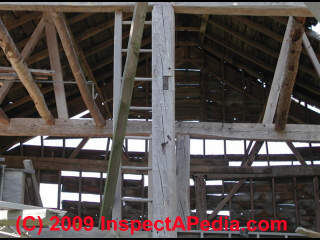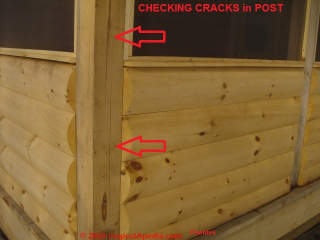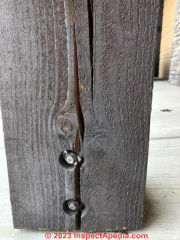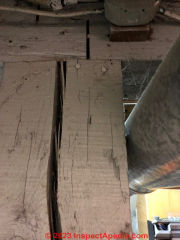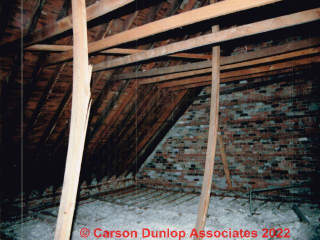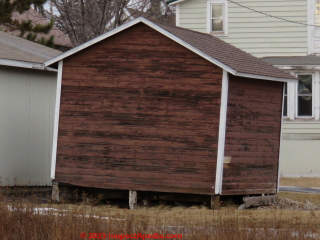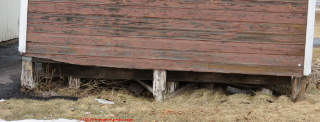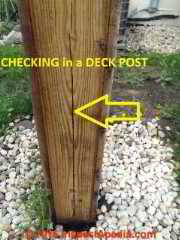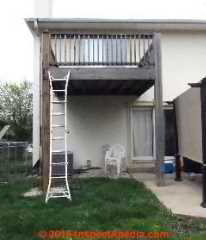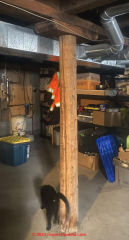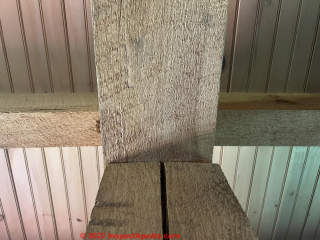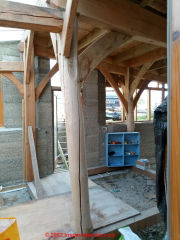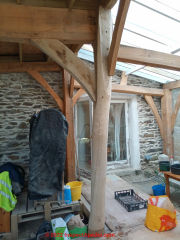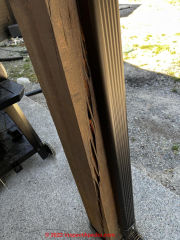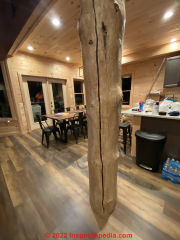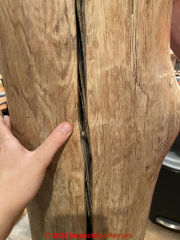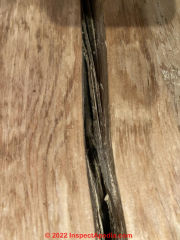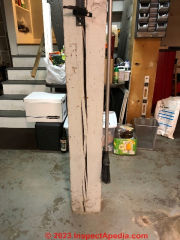 Evaluate Vertical Cracks & Splits in Wood Posts
Evaluate Vertical Cracks & Splits in Wood Posts
Cause, Effect, & Dealing with Vertical Splits in Wood or Log Posts
- POST a QUESTION or COMMENT about vertical splits or cracks in wood beams or in log home log walls
How to evaluate vertical cracks or splits in wood posts or logs.
This article defines, illustrates, and explains the cause and significance of vertical splits or "checking" in wooden posts or logs used in log homes.
Here we provide a guide to diagnosing and evaluating the impact of vertical splits or checking found in wooden posts used in homes, barns, post-and-beam buildings, pole barns, and to support decks or porches.
Our page top photo shows 3/16" wide checking splits in the wood post of a basement home, courtesy of reader Levi. This is normal log dryout checking or splitting. But below on this page we show the top of this post and its poor connection to an overhead "beam".
As solid wood posts and logs cure, shrinkage produces not only checking (large cracks that are normal and are not necessarily a problem) but also an actual reduction in log or post diameter.
InspectAPedia tolerates no conflicts of interest. We have no relationship with advertisers, products, or services discussed at this website.
- Daniel Friedman, Publisher/Editor/Author - See WHO ARE WE?
Evaluating Splits & Cracks in Wooden Columns, Posts, or Logs
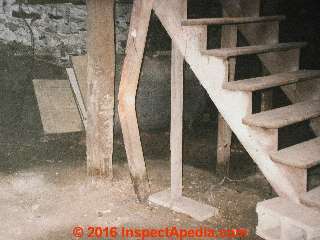 This article describes splits that are found in vertical wood and log posts.
This article describes splits that are found in vertical wood and log posts.
Checking or splits in wooden posts or in solid logs used to construct both antique and modern log houses worry homeowners even though usually they do not present a structural problem.
However checks in structural wood beams as well as checks and splits in logs used to construct log homes can result in water or air leaks into the building.
[Click to enlarge any image]
Photo: a bending, cracking, and failing wood post by the stairwell of a pre-1900 home in New York.
This post is seriously damaged, risking structural collapse. This is not mere wooden post checking.
While extreme loading can cause a wood beam (or more rarely a post) to split and would indicate a sign of impending disastrous collapse, usually the splits or cracks found in wooden posts are due to shrinkage as wood dries, occur along the grain, and do not raise a structural concern.
Is the wooden structural component we are discussing a Post or a Beam ? If it's vertical, it's a post, and if it's horizontal, it's a beam, as we illustrate in our photo above.
In some texts, what we're calling a post may also be referred to as a column, though we prefer to reserve that word for vertical supports made of steel or masonry. If it's wood we like to call a vertical support a post.
If it's diagonal, it's a brace or part of a truss.
For help evaluating cracks, checks, or splits found in horizontal wood beams and logs, see
CRACKS CHECKS or SPLITS IN HORIZONTAL BEAMS
Evaluating Splits or Cracks in Wooden Posts
The wood posts shown above are in big trouble, as is this whole building. In this photo we have a set of old locust wood posts that are bending and breaking as the whole building is collapsing. The root problem in this wood structure collapse-in-process is the inwards collapse of the concrete foundation wall.
Someone has propped an "emergency" post in one location under one floor joist, leaning at an angle and not anchored at top or bottom.
Watch out: this building is in danger of sudden, catastrophic collapse.
In contrast, look at the post checking crack photo just below, courtesy of an anonymous InspectApedia.com reader.
In this post we see normal, typical dry-out checking cracks in a wood post. (We can't see the structural connections at the post top and bottom - those, too, always deserve inspection.)
But as long as cracks like this can be characterized as typical wood-post or wood-beam checking, and as long as the crack does not appear where it compromises a structural connector between the post top and an overhead beam or between the post bottom and its support pier, then those splits found in vertical posts are not a structural concern.
Placed vertically the post is in compression and these cracks or splits don't affect its ability to carry a load - unless you see that the post is actually bending, leaning, dis-connected, or damaged by rot or insects the post should be acceptable.
Checking cracks in a post such as in the post-and-beam constructed barn shown here are not going to be flagged as a concern by your building inspector nor other experienced field investigators. This post, observed in a barn in northeastern U.S. is more than a century old and still doing its job.
Watch out: While checking-cracks in a vertical post are harmless, as we illustrate just below, overloading, rot, insect damage, or side-loading can indeed cause failure of a wooden post and risks catastrophic building collapse.
Below: Harmless checking cracks in a corner post of a log home, courtesy of Arlene Puentes.
Example of Failures Due to Cracks in Wood Posts
Below are two examples of cracks or splits in a wood post that deserve attention.
Above: this post has split right where two through-bolts are intended to connect it to another structural member or bracket or brace (not visible as it's on the other side of the post).
A split in this location, even though it doesn't go all the way through the post, may compromise the strength of its structural connectors. Further investigation is needed and repair by reinforcement may be needed.
Below is our page top photo again, showing harmless checking cracks in a wood post.
Really? Well not quite. The post itself is perfectly capable of doing its job in a typical basement of a two story home where it's located below a main beam or girder. But let's look more-closely at the top of this post to its connection to the "beam" overhead.
That's a rather iffy connection of post to beam, with marginal bearing surface of the right-hand beam and just two toe-nails making the connection. While we're not afraid of a sudden precipitous collapse, a better post-to-beam connection would be in order, perhaps using a bolted T-strap.
Examples of Breaking Failures in Wood Posts
The most common causes of serious failure in wooden posts include
- Under-sized and/or over-loaded post for the loads involved (shown above)
A wooden post may fail due to under-sizing, like the photos shown just above, courtesy of Carson Dunlop Associates, a Toronto home inspection & report writing tool company - Missing, inadequate, or improper structural connections between post and beams or piers
- Inadequate piers for posts resting at or on ground level
- Rot or insect damage to posts - illustrasted below.
- Less common: installed too far out of plumb or vertical position
Above: this Two Harbors, Minnesota shed is tilting and collapsing: a closer look shows that its supporting posts are rotting and crushing.
It looks as if these posts also had no masonry piers and may not have been built using rot-resistant treated wood.
Just below we see a wooden post that has broken, is bending and about to collapse, and that needs replacement.
This is not post checking nor cracking, it's post breaking. Notice also that this basement has had a history of flooding and that the bottom of many wood posts may be rotted or insect-damaged, risking further settlement or collapse.
Research on Wood Post Cracking / Splitting
- American Signumat 115 Wight Ave., #397 Cockeysville, MD 21030 TEL: (410) 592-2907 E-mail: heinz@americansignumat.com Website: https://americansignumat.com
- Thanks to Arlene Puentes for the photograph of a checked log post in a log home exterior. Arlene Puentes, a licensed home inspector, educator, and building failures researcher in Kingston, NY. Photographs © Arlene Puentes 2006 - 2023 All Rights Reserved. Text © Daniel Friedman Arlene Puentes 2008 - 2023 All Rights Reserved.
- Benabou, L. Finite strain analysis of wood species under compressive failure due to kinking [PDF] International Journal of Solids and Structures 49, no. 3-4 (2012): 408-419.
Abstract:
Finite element analysis of kink band formation in wood is carried out using an anisotropic failure criterion. The criterion is capable of describing the mixed mode I/mode II crack development observed in the kinked region. The evolution of cracking is simulated with the help of the so-called smeared crack approach.
As for the finite rotation of the fibers in the kinked material, it is implemented in the finite element code through a hypo-elastic law characterized by an objective derivate using the rotation of the fibers. This formulation enables to follow strictly the matter under finite strain; which means that the evolution of the orthotropic directions is correctly described.
Numerical results, such as the predicted load carrying capacity of wood under compression and its post-cracking behavior, prove to have a good agreement with the experimental observations. Further, the applicability of softening orthotropic plasticity under finite strain conditions for simulating compressive failure modes in wood is established. - Bulleit, William M., David V. Rosowsky, Kenneth J. Fridley, and Marvin E. Criswell. "Reliability of wood structural systems." Journal of Structural Engineering 119, no. 9 (1993): 2629-2641.
Abstract:
The state of the art of reliability analysis of wood structural systems is discussed. Both wood‐system behavior and system‐reliability analysis are included. Potential areas for research that could lead to better techniques for both reliability analysis and reliability‐based design of wood systems are considered.
The suggested research areas, while emphasizing gravity‐loaded systems, have analogous counterparts for systems loaded by wind and earthquake. All wood systems need to be examined in more depth from a modeling and behavior standpoint, particularly with respect to simplified models suitable for reliability analysis.
Ultimate capacity reliability is emphasized, but serviceability reliability considerations are also included. Perhaps the most important research area discussed is the characterization of the various types of wood systems so that limit‐state definitions can be developed. - Kharouf, N., G. McClure, and I. Smith. Elasto-plastic modeling of wood bolted connections [PDF] Computers & structures 81, no. 8-11 (2003): 747-754.
Abstract:
A plasticity based constitutive compressive material model is proposed to model wood as elasto-plastic orthotropic according to the Hill yield criterion in regions of bi-axial compression. Linear elastic orthotropic material response is applied otherwise with maximum stresses taken as failure criteria.
The model is implemented in the finite element code to carry out the analysis of bolted connections using ADINA software. Reasonable agreement is found between numerical simulations and experimental measurements of local and global deformation of one-bolt connection. The predicted failure modes are consistent with experimental observations. - Patton-Mallory, Marcia, Patrick J. Pellicane, and Frederick W. Smith. "Modeling bolted connections in wood." Journal of structural engineering 123, no. 8 (1997): 1054-1062.
- Sandhaas, C., and J. W. G. Van de Kuilen. MATERIAL MODEL for WOOD [PDF] Heron 58, no. 2-3 (2013): 171-91.
Discusses post elastic behaviour.
Abstract:
Wood is highly anisotropic and shows ductile behaviour in compression and brittle behaviour in tension and shear where both failure modes can occur simultaneously. A 3D material model for wood based on the concepts of continuum damage mechanics was developed.
A material subroutine containing the developed model was implemented into a standard FE framework. Eight stress-based failure criteria were derived in order to formulate piecewise defined failure surfaces.
The damage development of wood was controlled by nine damage variables. Embedment tests using three different wood species (spruce, beech, azobé) were carried out whose results were compared to modelling outcomes.
The failure modes could be identified and the general shape of the load-displacement curves agreed with the experimental outcomes up to a numerical limit.
Key words: Constitutive model, timber, wood, continuum damage mechanics, finite element method - Sheetz, Ron & Charles Fisher, PROTECTING WOODWORK AGAINST DECAY USING BORATE PRESERVATIVES [PDF] (1993) Exterior Woodwork No. 4, National Park Service, U.S. Department of Interior, Denver Service Center, Design & Construction, 12795 West Alameda Parkway, P.O. Box 25287,
Denver, CO 80225-0287 USA, retrieved 2018/11/16, original source: https://www.nps.gov/tps/how-to-preserve/tech-notes/Tech-Notes-Exterior04.pdf
- Burke, Steven M., & Marlys Bush Thurber, HISTORIC STRUCTURE REPORT, SOUTHWEST REGION HEADQUARTERS BUILDING Santa Fe, New Mexico, [PDF], National Park Service, Southwest Cultural Resources Center Professional Paper No. 6,
U.S. Department of the Interior,
National Park Service,
Santa Fe, New Mexico,
March 1985
- Leonardi, Angela, A. Meda, and Z. Rinaldi. "Fire‐damaged R/C Members Repair With High‐Performance Fibre‐Reinforced Jacket." Strain 47 (2011): 28-35.
...
Reader Comments, Questions & Answers About The Article Above
Below you will find questions and answers previously posted on this page at its page bottom reader comment box.
Reader Q&A - also see RECOMMENDED ARTICLES & FAQs
Reader Question: how dangerous are these cracks in the posts supporting our deck?
2016/05/11
I sent picture of my balcony [above and below], and I would like your opinion about the post in the picture it is 5.5”x5.5”.
It has a crack 1/8”,I don’t know how many year has been there .The dimension of balcony are 10’x10’ x10’ high - Anon by private email
Reply:
With the WARNING that nobody can conduct a proper safety inspection by email, and that other defects such as improper fasteners or improper construction can certainly cause a fatal deck collapse,
The crack in your photo in the center of a 6x6 pressure treated post is common, it's called "checking", and it has no structural significance at all. Search InspectApedia.com for "checking in wood beams" to read details and to see more examples.
Thanks for the photos - those may help other readers as posted here - keeping you anonymous of course unless you want to be identified as a technical contributor.
Watch out: Stay safe, don't fall off that ladder, and be sure that your deck was properly built with proper structural connections at all points, particularly to the building and between deck and posts; it should have had a building permit and a CO inspection.
Common causes of deck collapse include
- Deck ledger not properly bolted to the house
- Deck beams not properly connected to the posts
- Deck posts not properly secured to piers at ground level
Those are not details one can see in your photos. Less often (I think) decks collapse due to rot that in turn may be aggravated by improper construction or improper flashing.
Also be sure that the deck guardrails are safe, secure, well fastened, and at proper height and spacing.
See GUARDRAIL CONSTRUCTION, STAIRS.
See DECK COLLAPSE Case Study for a detailed example of what can go wrong that causes a dangerous deck collapse.
Also see DECK FLASHING LEAKS, ROT Case Study
Question: are the splits in this wooden post a structural problem?
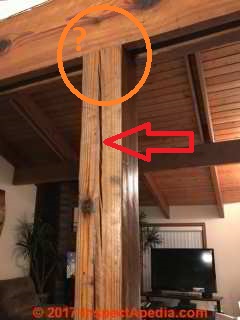 Our home was built in 1979 and we have a support beam running from the first floor to the second floor that has a crack in it.
Our home was built in 1979 and we have a support beam running from the first floor to the second floor that has a crack in it.
The crack has been there since we purchased the property five years ago and we're wondering whether it's a concern.
We didn't take any measurements initially so we don't know how much the crack has grown (presumably the crack would get worse over time).
As best we can tell, the crack extends inside to a third of the beam at the deepest point.
Some photos are attached. Any advice would be appreciated. - Anonymous by private email 2017/12/27
Reply:
The photos look to me like normal checking that occurs in wood posts and beams (red arrow).
Such spits can appear and even increase after original construction, as drying causes normal checking in a 4x4" or 6x6" post like that in your photos; it may have been installed while still a bit green or damp.
Your observation that the splits extend to a depth of about 1/3 of the post's thickness is consistent with this opinion.
Only if a post were split clear through, so that you could see daylight right through the thickness of the post, would I be concerned about its adequacy.
Watch out: however I do have a different structural question or possible concern: the post appears to support an overhead beam composed of two 2x10's or larger, spaced about an inch apart. I cannot see anything that actually connects the post to the overhead beam (orange circle), and I cannot see how the two 2x's, spaced apart as they are, are connected together.
Such a spaced beam may be have been specified and designed by an engineer or architect and might be perfectly adequate.
But when I cannot see a post-to-beam connection and when I see the overhead composite 2x lumber components that form the beam are spaced apart with no visible blocking nor connections between them, I am left questioning how the structure is held safely together besides more than gravity.
On 2023-06-12 by InspectApedia DF (mod) - 6" x6" deck post is cracking and has a small bow in it
@BK,
If you could share a photo or two showing us the post of concern, that would help us have a clearer idea of the look and size of the bow.
You can only add one image per comment but as many comments as you like.
If the post was bowed or slightly bent at time of installation it's not likely to be a concern.
If the bowing/bending is new it's worth a closer look. See general and easy procedures for measuring lean, bulges, bowing in any structural component at
BULGE or LEAN MEASUREMENTS
It's easy.
Cracks or splits in posts are discussed and evaluated above on this page: please read through that and then don't hesitate to post any follow-up questions or comments you may have.
For allowable sag or deflection in horizontal beams, floors, etc. see
DEFLECTION in WOOD BEAMS ROOFS FLOORS
On 2023-06-12 by BK
My new 6" x6" deck post is cracking and I believe that's fine, but one of them has a small bow in it, will the post be ok and should I be worried about it.Thanks
On 2023-04-19 by InspectApedia Publisher - structure could be unsafe if you see new and significant bulging and cracking of posts supporting ANY structure.
@Nicole Protain,
With the apology that we can't see your house and know nothing about it's age, construction, condition, I can say that it's certainly a reasonable concern that the structure could be unsafe if you see new and significant bulging and cracking of posts supporting ANY structure.
At the very least you need an experienced onsite contractor who can add temporary support to be sure there is not more extensive or sudden or dangerous movement or falling of the porch.
Lifting a building requires experience and expertise, and should be accompanied by a thorough pre and post-job inspection to be sure that there has been no damage and that ALL of the building supporting components are proper.
Perhaps you could post some photos - one per comment - and do keep us informed on what else your onsite people have to say.
On 2023-04-19 by Nicole Protain
My home was raised 3feet and leveled last year in April and since August/September of 2022 the posts that hold up my roof over my patio have bowed and one is cracked pretty severely.
I need to know if this will cause any structural problems. The foundation company that did the work and replace everything keep telling me its normal and to just paint them.
On 2023-02-11 by InspectApedia Publisher - sudden decrease in indoor humidity can cause shrinkage checking cracks
@Samantha,
It makes sense that a sudden decrease in indoor humidity would cause shrinkage checking cracks in many heavy wooden beams or posts in such an area, all at about the same time.
On 2023-02-11 by Samantha
@InspectApedia Publisher,
Very unsettling for all of them to happen at once, and so equally. Weve been discussing having the beam and posts replaced as the beam is a little thin at 3 inches, but didn’t want to have to do that like this weekend lol
Thank you for your knowledge! You’ve given many more things to inspect now too.
On 2023-02-11 by InspectApedia Publisher
@Samantha,
We're glad to assist. I understand that seeing a big "crack" in wood beams or posts can be unsettling. Happily this is a well-understood phenomenon.
On 2023-02-11 by Samantha
@InspectApedia Publisher, thank you! I throughly read your extremely informative site. I did not even know checking was a thing until I came here, so thank you for that.
I’m actually thinking they may have split now as the ground under the concrete finally dried up last week, but is now filled back up with the current thaw.
I’ve been measuring these cracks each day now too.
On 2023-02-11 by InspectApedia Publisher
@Samantha,
I expect you will read above that this type of beam checking is not a structural concern unless it compromises a structural connection. It seems likely that adding that stove sped / increased the drying of the wood beams.
You will want to be sure that your woodstove was installed with a proper permit, safely inspection, and fire clearance distances respected.
On 2023-02-10 by Samantha
The three Timbers supporting my bungalow have all spilt last week 3/8inch. We had a wood stove installed in December, and I am wondering if this is normal checking from the stove drying them out, or a much larger concern.
The house was built in 1958, but I’m not sure when the basement was done. DIY for sure though since the floor is below the basement footing. Thank you!
On 2023-01-26 by InspectApedia Publisher - Checking cracks are common in a vertical post
@Deborah,
Checking cracks are common in a vertical post and are harmless unless by bad luck their location interferes with a structural connection, such as to that overhead beam.
But be sure to check beam and also the post, esp. post bottom, for rot.
On 2023-01-25 by Deborah
We have a vertical beam that supports 2 horizontal beams. The protruding roof is supported by the 2 horizontal beams.
The vertical beam has been put in place 30 years ago and there are multiple cracks. These kind of cracks can be found at each of the 4 sides (only uploaded a picture of the front). Could it be a structural issue at this moment?
I don't think there are big cracks at the connection point between the horizontal beams and vertical beam. The cracks don't go fully through the beam, but as there are cracks at all sides, I'm worried that at one point the cracks will connect.
If we would ever replace the protruding roof in the future, would it be a good idea to replace the vertical beam as well?
All the best
On 2022-10-24 by InspectApedia (Editor) - home's center post is split
@Anonymous, .
How is the post connected to the beam?
Looks like 2 beam ends meet over a post.
NO structural connection is visible. Check further.
On 2022-10-24 by Anonymous
This post is in the center of the house with the split running straight down the middle from top to bottom. Is it holding too much weight? The beam also seeems to no be sitting flush on top of it
On 2022-10-20 by InspectApedia (Editor) - Ireland sweet chestnut post is splitting and not fully on floor plate
@Mike C,
I'll be glad to think about suggestions for a post if we first agree on just what problem we're solving.
I'm not sure of the issue in this case.
If you're referring to a split - log checking crack - in a vertical post, there's no repair needed unless the split has compromised a structural connection.
Checking cracks in a post ( a vertical "beam") are not normally a worry at all as long as they don't run across a structural connector such as a bolt or peg.
On 2022-10-14 by Mike C
The split in this Sweet Chestnut post has gotten slightly bigger in the last year since it was erected. The building is not yet fully closed in. The squared timbers are all Douglas and it's in Ireland.
Also as you can see, the post is obviously not straight and ended up not fully sitting on floor plate. The large beam on the right supports a flat roof with osb, insulation, ply and EPDM, so it is a substantial weight.
If the post is a problem, how can I remedy it, ideally by adding something, rather than replacing the post, as getting the joinery right on a new post is unlikely to be possible.
On 2022-08-09 by InspectApedia-911 (mod) - vertical shear fracture in patio post
@Chris,
 Thank you for a helpful question and photo.
Thank you for a helpful question and photo.
You know, out of hundreds of checking cracks in posts that almost never need attention, in my OPINION (I'm not a wood nor structural engineer) that post ought to be replaced. It's not a big job but I recommend it.
I see what looks almost like a vertical shear fracture - as if there is a combination of drying-checking-splitting and vertical loading from above. I can't see into the crack very well but the little I can see hints that the condition of the post core may not be normal wood fibres - perhaps rotted - a defective post to start-with.
By "patio" I think you mean what I call a deck - a flat wood structure above ground.
The repair involves a tiny bit of jacking, temporary support, placement of the new post on a good pier, and connecting the post to the deck framing and to the pier.
Keep us posted, maybe with photos of the repair and we may be able to comment further.
On 2022-08-09 by Chris
We have a new built home that was finished in 2021. We live in northwest Montana. We have 2 beams on back patio that are starting to concern me. You can see by the paint where the horizontal beam has twisted and the checking on the vertical beam which has grown.
On 2022-07-04 by InspectApedia-911 (mod)
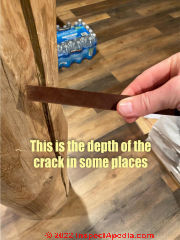 @Brittany,
@Brittany,
Great photos: that's normal log checking, not a worry.
Your photo, showing that the splitting or checking crack depth is
up to nearly 1/2 the log's total diameter,
can be scary but in fact that's also normal,
especially if the post was wet or green when installed.
On 2022-07-04
by Brittany
This is a load bearing timber. We just got AC and I don’t believe this crack was this large before. Is this cause for structural concern?
...
Continue reading at WOOD BEAM LOG VIGA CRACK REPAIR METHODS or select a topic from the closely-related articles below, or see the complete ARTICLE INDEX.
See also CRACKS CHECKS SPLITS in BEAMS, LOGS, VIGAS & POSTS FAQ - questions & answers posted originally on this page
Or see these
Recommended Articles
- ANTIQUE & OLD LOG CABINS
- CRACKS CHECKS or SPLITS IN HORIZONTAL BEAMS
- CRACKS CHECKS or SPLITS IN VERTICAL POSTS
- DECK COLLAPSE Case Study
- DECK POST CONSTRUCTION
- DEFLECTION in WOOD BEAMS ROOFS FLOORS
- FRAMING DAMAGE, INSPECTION, REPAIR - home - advice on looking for damaged, unsafe wood structure framing
- GLUES ADHESIVES, EXTERIOR CONSTRUCTION
- LOG HOME GUIDE
- ROT, TIMBER FRAME - cause and prevention of log checking during log or timber dry out, & a case study of rot in timber frame construction
- ROT, TIMBER ASSESSMENT
- ROT TYPES, BROWN SOFT WHITE
- SHRINKAGE & HEIGHT CHANGES, LOG WALL
- WOOD BEAM LOG VIGA CRACK REPAIR METHODS
- WOOD STRUCTURE ASSESSMENT - home
Suggested citation for this web page
CRACKS CHECKS or SPLITS IN VERTICAL POSTS at InspectApedia.com - online encyclopedia of building & environmental inspection, testing, diagnosis, repair, & problem prevention advice.
Or see this
INDEX to RELATED ARTICLES: ARTICLE INDEX to BUILDING STRUCTURES
Or use the SEARCH BOX found below to Ask a Question or Search InspectApedia
Ask a Question or Search InspectApedia
Questions & answers or comments about splits or cracks in wood beams or in log home log walls.
Try the search box just below, or if you prefer, post a question or comment in the Comments box below and we will respond promptly.
Search the InspectApedia website
Note: appearance of your Comment below may be delayed: if your comment contains an image, photograph, web link, or text that looks to the software as if it might be a web link, your posting will appear after it has been approved by a moderator. Apologies for the delay.
Only one image can be added per comment but you can post as many comments, and therefore images, as you like.
You will not receive a notification when a response to your question has been posted.
Please bookmark this page to make it easy for you to check back for our response.
IF above you see "Comment Form is loading comments..." then COMMENT BOX - countable.ca / bawkbox.com IS NOT WORKING.
In any case you are welcome to send an email directly to us at InspectApedia.com at editor@inspectApedia.com
We'll reply to you directly. Please help us help you by noting, in your email, the URL of the InspectApedia page where you wanted to comment.
Citations & References
In addition to any citations in the article above, a full list is available on request.
- Thanks to Arlene Puentes for the photograph of a checked log in a log home exterior. Arlene Puentes, a licensed home inspector, educator, and building failures researcher in Kingston, NY. Photographs © Arlene Puentes 2006 All Rights Reserved. Text © Daniel Friedman Arlene Puentes 2008 All Rights Reserved.
- In addition to citations & references found in this article, see the research citations given at the end of the related articles found at our suggested
CONTINUE READING or RECOMMENDED ARTICLES.
- Carson, Dunlop & Associates Ltd., 120 Carlton Street Suite 407, Toronto ON M5A 4K2. Tel: (416) 964-9415 1-800-268-7070 Email: info@carsondunlop.com. Alan Carson is a past president of ASHI, the American Society of Home Inspectors.
Thanks to Alan Carson and Bob Dunlop, for permission for InspectAPedia to use text excerpts from The HOME REFERENCE BOOK - the Encyclopedia of Homes and to use illustrations from The ILLUSTRATED HOME .
Carson Dunlop Associates provides extensive home inspection education and report writing material. In gratitude we provide links to tsome Carson Dunlop Associates products and services.


